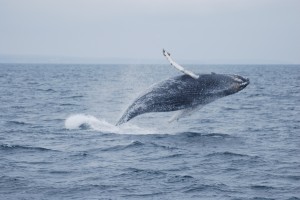
Humpback calf breaching
Whale watching is thrilling, a mini-adventure where you get to experience the open ocean, feel the wind on your face and on a very good day, see whales and dolphins perform astonishing aerial behavior such as breaching and leaping.
Breaching is when a whale leaps out of the water giving whale watchers the show of a lifetime, a breath taking experience not to be missed. Breaching is the term used when large whales leap and leaping is the term used when dolphins leap. But did you know that dolphins are whales, just small-toothed whales? So really it’s just a nuance of terminology, breaching, leaping, it’s the same thing.
According to the Encyclopedia of Marine Mammals, breaching “is defined as a jump in which at least 40% of the animal leaves the water.” Humpback whales are particularly famous for their acrobatic abilities and amazing stunts, frequently launching their 50 foot long bodies out of the water creating massive splashes as 45 tons worth of weight crashes back into the water.
The Encylopedia of Marine Mammals lists humpback, right and sperm whales and all offshore dolphins as the most frequent breachers. And authors Bernd Wursig and Hal Whithead note that calves of many whale species breach more than adults, which is not surprising because children always have more fun!
But why do whales breach? Are they just having fun, is it some sort of communication, does it serve a purpose?
Scientists don’t have definitive answers to these questions. There seems to be a variety of reasons, but all are speculative. Maybe the whales are just having fun, jumping for joy in the ocean. Or breaching might allow whales to remove stubborn barnacles or fish that are hitching rides. Or the splash landing noise could be a form of communication. The authors note that “one of the most interesting, and in some ways unexpected, findings that has emerged from several studies of different species is that breaching rates of large whales increase with wind speed.”

Humpback calf splash
This pattern doesn’t have an explanation, but could be another indication of communication since the noise associated with the splash might be a better way to communicate during windy surface conditions. But to me faster winds could also mean more fun! If a whale leaps out of the water when the wind is really blowing, there’s a better chance of catching a lift and getting a real thrill.
But for now we can only speculate and wonder why whales breach and dolphins leap. If only we could just ask them.
Thanks for another great post! And what an awesome breaching picture!